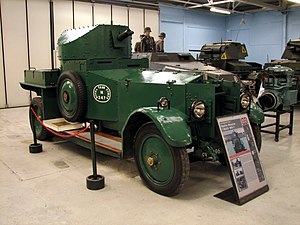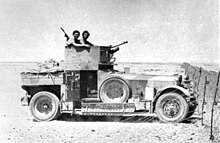Rolls-Royce Armored Car
| Rolls-Royce Armored Car | |
|---|---|

Executed in a museum in 1920 |
|
| General properties | |
| crew | 3 men |
| length | 4.93 m |
| width | 1.93 m |
| height | 2.54 m |
| Dimensions | 4.7 tons |
| Armor and armament | |
| Armor | 12 mm steel |
| Main armament | Vickers MG 7.65 mm (0.303 in) |
| agility | |
| drive | 6-cylinder petrol engine (Rolls-Royce) 80 HP (59 kW) |
| suspension | Leaf springs |
| Top speed | 72 km / h |
| Power / weight | 19 hp / ton |
| Range | 240 km |
The Rolls-Royce Armored Car was a British armored car that was developed in 1914 and used during World War I and at the beginning of World War II .
production
The Royal Naval Air Service established the first British armored car division during World War I. In September 1914, all available chassis of the Silver Ghost including their engines, which had been increased to 80 bhp (59 kW) in the meantime, were requisitioned and formed the basis for the new armored car. In the following month, a special department of the Air Department of the British Admiralty , including Flight Commander TG Hetherington , constructed a structure for these chassis, which consisted of an armored body and a turret to accommodate a single Vickers machine gun .
The first three vehicles were delivered on December 3, 1914, although by that time the mobile war on the Western Front, in which the simple forerunners of the Rolls-Royce were used, had already ended. The production of the chassis was stopped in 1917 so that Rolls-Royce could concentrate on the production of aircraft engines.
In 1920 and 1924 the vehicle was modernized, which resulted in the Rolls-Royce armored car version 1920 and the Rolls-Royce armored car version 1924 . In 1940 the “old” turret was replaced by an open-topped one on 34 vehicles that were used in Egypt with the 11th Hussar Regiment of the British Army, which was equipped with a Boys anti- tank rifle , a 0.303 inch Bren machine gun and a smoke grenade launcher.
Some vehicles in Egypt got a new chassis from Fordson trucks and became known as Fordson Armored Car . Photos show that they were armed with a Boys anti-tank rifle, a machine gun and two light machine guns for air defense.
A total of 120 copies were made during the First World War.
commitment
Six RNAS Rolls Royce squadrons with 12 vehicles each were formed: one went to France, one went to Africa to fight in the German colonies and two were used in the Battle of Gallipoli in April 1915 . From August 1915 they were all disbanded and their material handed over to the British Army , which used them in the light, armored motor batteries. For the muddy, with trenches crisscrossed battlefields of the Western Front , the armored cars were extremely ill-suited, but proved to be ideal for use in the Middle East . So the squadrons were moved from France to Egypt.
Lawrence of Arabia used such a vehicle in his operations against the Turkish forces. He called the unit of nine Rolls-Royce armored cars "more valuable than rupees" for the victory of the "revolt in the desert". He took this view all his life, and when a journalist asked him what was most valuable to him, he replied: "I would like to have my own Rolls-Royce and enough tires and gasoline for my entire life."
During the Irish Civil War (1922–1923) the British government left 13 Rolls-Royce armored vehicles to the Free State of Ireland to use against the IRA . In street fights and protecting convoys, the armored vehicles were of great advantage and made a significant contribution to the retaking of the cities of Cork and Waterford . Amazingly, despite massive maintenance problems and difficulties with the Irish weather, they remained in service until 1944 and were only decommissioned when new tires were no longer available. 12 of these cars used by the Irish Army were dismantled and sold in 1954. One with the registration number ARR-2 and the name Sliah na mBan was retained by the army and it is widely believed that he was part of the column of IRA leader Michael Collins on August 22, 1922 , when he died in a gun battle . This Rolls-Royce Armored Car is one of only two that still exist today and is regularly shown at parades and open days; mostly it drives on its own. He is being serviced by the Army Logistics Corps at Curragh Camp. One of the 12 cars sold (ARR-1 Danny Boy / Tom Keogh ) survived at a collector in England.
When the Second World War broke out, 76 vehicles were in use. They were fought in the Desert War in the Western Desert (June 11, 1940 to February 4, 1943), in the British-Iraqi War (May 2 to 31, 1941) and in the Syrian-Lebanese Campaign (June 8 to July 14, 1941 ) used. In late 1941 they were decommissioned as newer armored cars were available. Some Rolls-Royce armored cars, version India , were used on the Indian subcontinent and in Burma .
variants
- Version 1920 Mk I - thicker radiator armor and new wheels
- Version 1920 Mk IA - armored turret for the commander.
- Version 1924 Mk I - gun turret with tank turret for the commander
- India version - based on the 1920 version. It had extended body armor with more space inside and a gun dome with four ball bearings for machine guns
- Fordson - based on the 1914 version. Some vehicles in Egypt got a new chassis from Fordson trucks
The turret of a single test vehicle was dismantled and replaced by an automatic 1-pounder anti-aircraft gun. Some vehicles had Maxim machine guns instead of the Vickers machine guns.
today
- A Rolls-Royce Armored Car version 1920 Mk. I is on display in the Bovington Tank Museum in Bovington . The vehicle can be seen in the inter-war gallery.
- Another such vehicle is called "one of our most important exhibits" by David Willey, curator of the Tank Museum in Dorset.
Web links
- Equipment Used By the Armored Car Regiments , Btinternet.com (English) ( Memento from September 29, 2007 in the Internet Archive )
- FV438 Carrier, Launcher, GW, Swingfire, Full Tracked (1969.118) , Tankmuseum.co.uk (English)
- War Diary of Armored Car Section, Rangoon Battalion, BAF , Armored Car Section, BAF (English)
source
Moschanskiy, I. Armored vehicles of the Great Britain 1939-1945 part 2 , Modelist constructor Bronekollektsiya (1999-2002) (И. Мощанский - Бронетанковая техника Великобритании 1939-1945 часть 2 , Моделист-Конструктор, Бронеколлекция 1999-2002)
Individual evidence
- ↑ a b c d e f g h i j k l m n o p Motavalli, Jim: The Bulletproof Ghost , Military History Issue 26, Weider History Group, Leesburg VA (04–05 / 2009), pp. 58–63
- ^ A b Willmott, HP & Kindersley, Dorling : First World War , (2003), p. 59
- ^ Pugh, Peter: The Magic of a Name - The Rolls-Royce Story: The First 40 Years , Icon Books (2001), ISBN 1-84046-151-9
- ^ Photo of a Fordson Armored Car ( Memento from May 16, 2011 in the Internet Archive )

